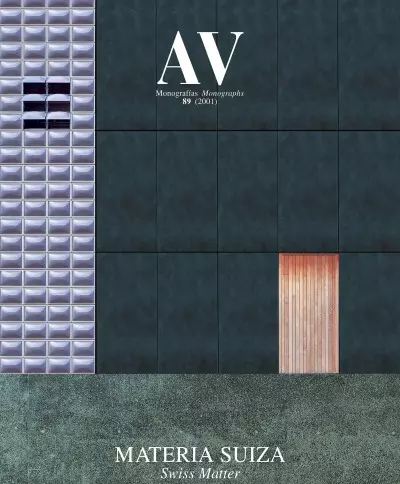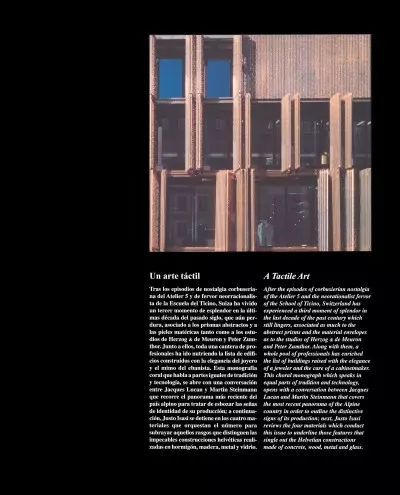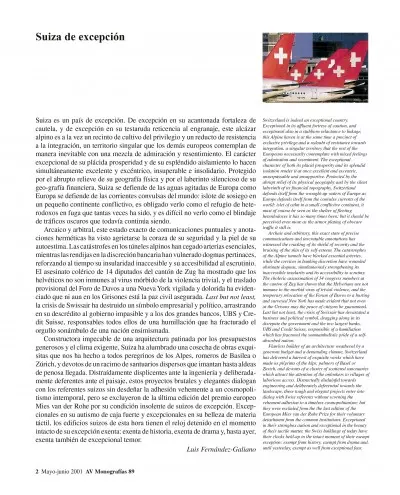MATERIA SUIZA
Swiss MatterLuís Fernández-Galiano
Suiza de excepción
Exceptional Switzerland
Un arte táctil
A Tactile Art
Jacques Lucan & Martin Steinmann
Construcciones helvéticas: tema y variacionesHelvetian Constructions: Theme and Variations
Justo Isasi
Pieles alpinas: hormigón, madera, metal y vidrio
Alpine Skins: Concrete, Wood, Metal and Glass
Hormigón por principioConcrete on Principle
Cabina de transformadores Transformer Station
Morger & Degelo
Terminal de equipaje, Zúrich Baggage Terminal, Zürich
Dürig & Rami
Escuela Volta, Basilea Volta School, Basel
Miller & Maranta
Tres villas, Beinwil am See Three Villas, Beinwil am See
Gmür & Vacchini
Tocar madera Knock on Wood
Vivienda unifamiliar, Flawil Family House, Flawil
Wespi & De Meuron
Casa para un carpintero, Grossdietwil House for a Carpenter, Grossdietwil
Blum & Grossenbacher
Establos y matadero, Vrin Stables and Abattoir, Vrin
Gion Antoni Caminada
Escuela de ingeniería maderera, Biel Wood Engineering School, Biel
Meili, Peter & Vogel
Tanteos metálicos Metallic Trials
Telesilla Carmenna, Arosa Carmenna Chair Lift, Arosa
Bearth & Deplazes
Polideportivo Buchholz, Uster Buchholz Sports Center, Uster
Camenzind & Gräfensteiner
Centro comercial, Lucerna Shopping Center, Lucerne
Diener & Diener
Parque-museo, Kalkriese (Alemania) Museum Park, Kalkriese (Germany)
Gigon & Guyer
Velos de vidrioGlazed Veils
Ampliación de escuela, Collombey School Extension, Collombey
Galetti & Matter
Biblioteca universitaria, Lausana University Library, Lausanne
Devanthéry, Lamunière & Freudenreich
Estadio St. Jakob, Basilea St. Jakob Stadium, Basel
Herzog & de Meuron
Pabellón deportivo, Zug Sports Center, Zug
Bétrix & Consolascio
Luís Fernández-Galiano
Exceptional Switzerland
Switzerland is indeed an exceptional country. Exceptional in its affluent fortress of caution, and exceptional also in a stubborn reluctance to linkage, this Alpine haven is at the same time a precinct of exclusive privilege and a redoubt of resistance towards integration, a singular territory that the rest of the Europeans necessarily contemplate with mixed feelings of admiration and resentment. The exceptional character of both its placid prosperity and its splendid isolation render it at once excellent and excentric, unsurpassable and unsupportive. Protected by the abrupt relief of its physical geography and by the silent labyrinth of its financial topography, Switzerland defends itself from the wrought-up waters of Europe as Europe defends itself from the convulse currents of the world: islet of calm in a small conflictive continent, it must of course be seen as the shelter of fleeting heterdodoxes it has so many times been; but it should be perceived even more as the armor plating of obscure traffic it still is.
Archaic and arbitrary, this exact state of precise communications and inscrutable annotations has witnessed the cracking of its shield of security and the bruising of the skin of its self-esteem. The catastrophes of the Alpine tunnels have blocked essential arteries, while the crevices in banking discretion have wounded obstinate dogmas, simultaneously strengthening its inaccessible insularity and its accessibility to scrutiny. The choleric assassination of 14 congress members at the canton of Zug has shown that the Helvetians are not immune to the morbid virus of trivial violence, and the temporary relocation of the Forum of Davos to a hurting and surveyed New York has made evident that not even at the Grisons may the peace of citizens be guaranteed. Last but not least, the crisis of Swissair has devastated a business and political symbol, dragging along in its disrepute the government and the two largest banks, UBS and Credit Suisse, responsible of a humiliation which has fractured the somnambulistic pride of a self-absorbed nation.
Flawless builder of an architecture weathered by a generous budget and a demanding climate, Switzerland has delivered a harvest of exquisite works which have made us pilgrims of the Alps, palmers of Basel or Zurich, and devouts of a cluster of scattered sanctuaries which attract the attention of the onlookers to villages of laborious access. Distractedly disdainful towards engineering and deliberately deferential towards the landscape, these tough and elegant projects enter into dialog with Swiss referents without scorning the vehement adhesion to a timeless cosmopolitanism; but they were excluded from the the last edition of the European Mies van der Rohe Prize for their voluntary detachment from the common institutions. Exceptional in their strongbox autism and exceptional in the beauty of their tactile matter, the Swiss buildings of today have their clocks held-up in the intact moment of their exempt exception: exempt from history, exempt from drama and, until yesterday, exempt as well from exceptional fear.








